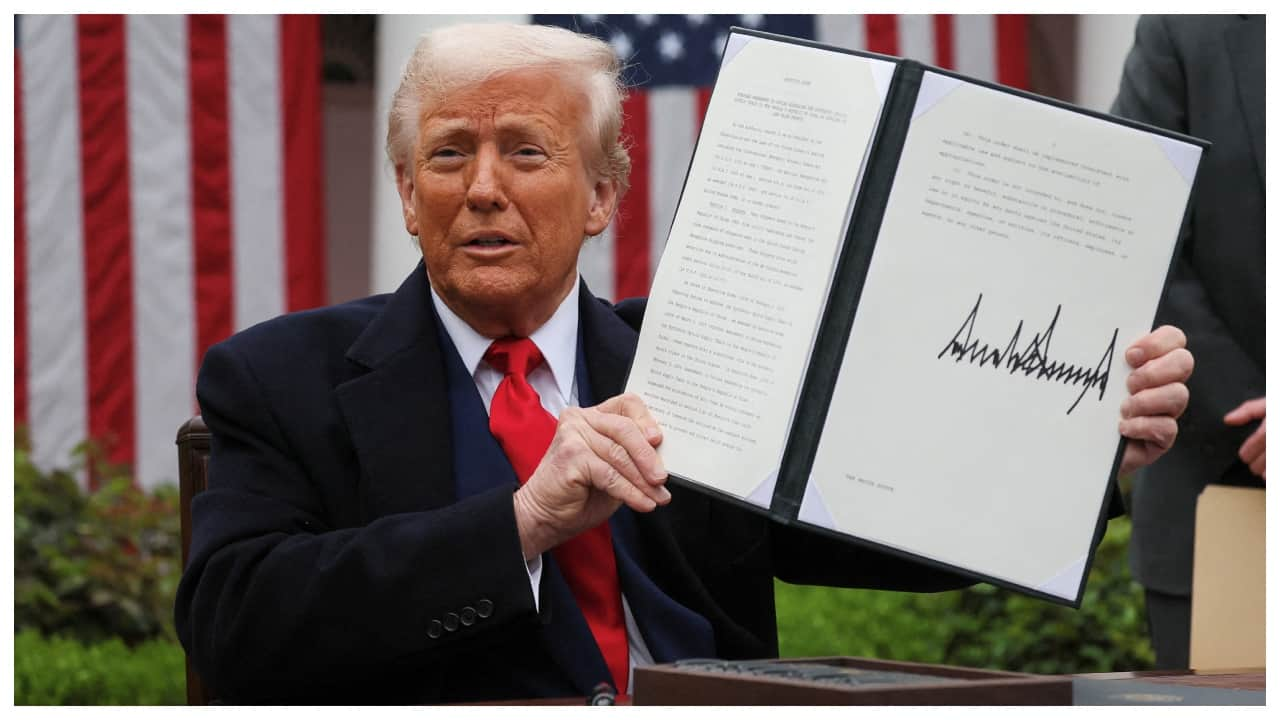Dear Reader , The Panorama newsletter is sent to Moneycontrol Pro subscribers on market days. It offers easy access to stories published on Moneycontrol Pro and gives a little extra by setting out a context or an event or trend that investors should keep track of. The backdrop of the White House Rose Garden was the sole calming factor on Wednesday April 2, as US President Donald Trump unleashed sweeping tariffs across countries.
Marking it as Liberation Day, the reciprocal tariffs that range from a baseline 10 percent to as high as even 60 percent in some cases, are, in Trump's view, retaliation to decades of looting, pillaging and plundering of the US by the rest of the world. But will the US really find its liberation through this move? Certainly not. Given that the US economy is import-dependent for most of its needs, these tariffs bring with it the risk of higher consumer prices.

That's a sure-shot dampener to demand that in turn could tip the US economy towards recession. Furthermore, the US Federal Reserve would have a limited leeway for rate cuts in an inflationary milieu. Anubhav Sahu from MC Pro Research writes that it is Trump 2.
0 which would be running short of time as elevated tariffs for long can sharply decelerate growth and defer investments. Worse, these reciprocal tariffs would have ramifications for global growth as well. Forecasts were already in place.
About a fortnight ago, the Organisation for Economic Co-operation and Development had cut global growth from 3.2 percent in 2024 to 3 percent in 2026 as economies struggle to rejig policies, both at home and outside, amid rising tariffs and changing geopolitical equations. In fact, my colleague Manas Chakravarty writes here that Trump has effectively nailed down the coffin of the 80-year old Rules-Based International Order that was born following the horrors of World War II, heralding a new world of peace, free trade, free markets, and global cooperation.
The old order is now survived by “chaos, uncertainty and might is right”, states Chakravarty. Another interesting article picked from the Financial Times (specially for MC Pro subscribers) points out that irrespective of whether Trump’s trade war chaos is fleeting or gets worse, the diplomatic cost will be enduring. “Countries will look to do the serious deals with each other and bypass America.
In that sense, Trump’s transactionalism is self-defeating. Falling trust means fewer deals,” says the writer, Edward Luce. To be sure, allies and enemies of the US are all perturbed.
China, its largest trade partner also blamed for US’ deficit economy, is faced with 34 percent tariffs on top of the 20 per cent previously imposed. Japan and the European Union that were not spared either, they too face 24 percent and 20 percent tariff rates, respectively. Trump’s tariff levies also leave little wiggle room, given that the base 10 percent tariffs go into effect on April 5 and the higher reciprocal rates on April 9! Cut to India, signals from the markets seem to suggest a mixed bag with some sectors such as IT, textiles and auto and auto parts hit hard while a few such as pharmaceuticals and semi-conductors got a breather from reciprocal tariffs.
MC Pro has a host of articles that detail whether US tariffs will derail India’s auto and auto parts sector , its impact on India’s textile industry that operates on wafer-thin profit margins, and why the US exercised restraint on the pharmaceutical sector. Indian indices that opened lower recovered some of their losses. Investors seem to believe that their country is not as badly off as its Asian peers, in terms of the magnitude of tariffs imposed.
There is hope in the government’s ability to fast track Bilateral Trade discussions in some sectors while also joining hands with some other nations in any adversity. That said, from all fronts -- be it political, economic or trade -- China could be a strong force to contend with, says Vivek Kelkar, in this article. As for investors, it may be time to gauge the industry sentiment that will come through in the management commentary during the coming quarterly results season.
My colleague Shishir Asthana briefly decodes the sectoral impact of tariffs for the Indian market, summing up that stocks of domestic-facing companies may see some activity in the near term while those with global exposure could see selling pressure. Investing insights from our research team Trump tariff strategy: Will India’s textile sector emerge stronger? EIH: Is there enough room for this hotel stock to grow? Should investors bet on a potential stake sale in this mutual fund? Will Trump’s reciprocal tariff dim the glitter of gems and jewellery? What else are we reading? Trump tariffs — A risky gamble or a whole new take on trade order? Chart of the Day: As job creation improves, will consumption follow suit? What should investors expect from bank results in Q4? China’s Tech Revolution: The force behind 2025’s market boom US imagines a new Weapon of Mass Destruction: Trade Deficit India’s Green Ambitions at Risk: Need to tackle currency devaluation risk Top challenges and opportunities in the digital payments ecosystem in India Tech and Startups AI won’t derail India’s GCC growth but will redefine it, say experts Technical Picks : NTPC, LICHSGFIN, TEJASNET Vatsala Kamat Moneycontrol Pro.















